Math 5110/6830 Homework 9.1 Solutions ˙x = 1 + rx + x 1.
advertisement
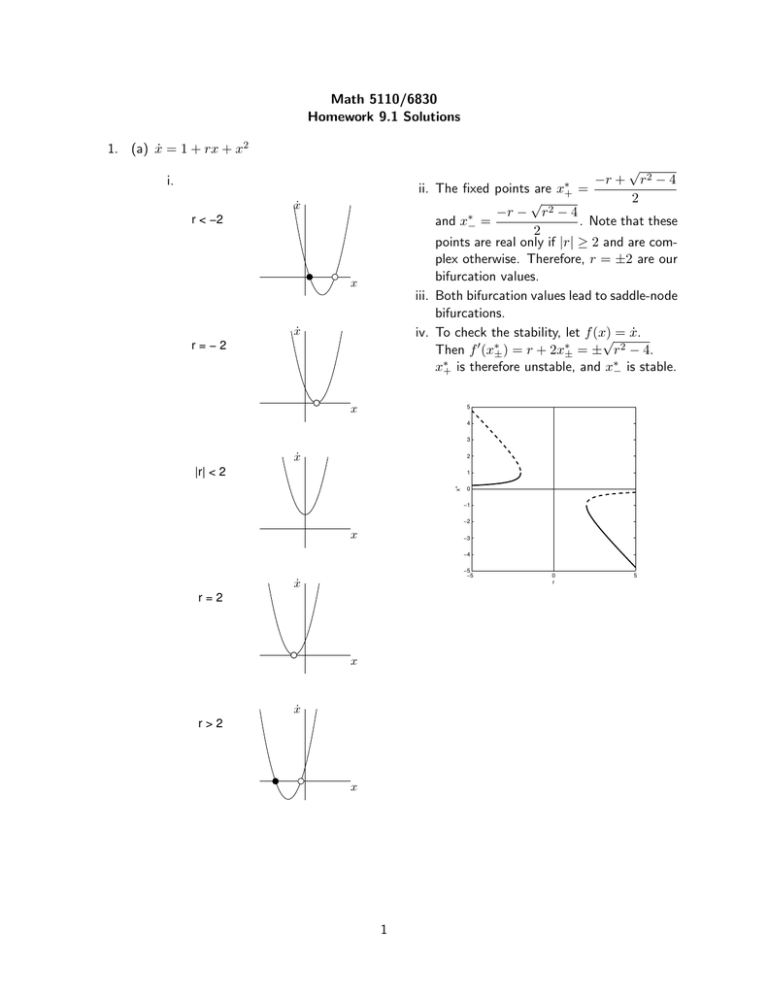
Math 5110/6830 Homework 9.1 Solutions 1. (a) ẋ = 1 + rx + x2 √ r2 − 4 ii. The fixed points are = 2 √ −r − r2 − 4 ∗ . Note that these and x− = 2 points are real only if |r| ≥ 2 and are complex otherwise. Therefore, r = ±2 are our bifurcation values. iii. Both bifurcation values lead to saddle-node bifurcations. iv. To check the stability, let f (x) √ = ẋ. Then f 0 (x∗± ) = r + 2x∗± = ± r2 − 4. x∗+ is therefore unstable, and x∗− is stable. i. x∗+ ẋ r < −2 x ẋ r=−2 x −r + 5 4 3 ẋ 2 |r| < 2 x* 1 0 −1 −2 x −3 −4 −5 −5 ẋ r=2 x ẋ r>2 x 1 0 r 5 (b) ẋ = x − rx(1 − x) ii. The fixed points are x∗ = 0 and x∗ = r−1 . The bifurcation value is r = 1. r iii. This is a transcritical bifurcation. iv. To check the stability, let f (x) = ẋ. ∗ 0 Then f 0 (x∗ ) = 2rx − r + 1 with f (0) = r−1 0 1 − r and f = r − 1. r ∗ So x = 0 is stable for r > 1, and x∗ = r−1 r is stable for r < 1. x i. r>1 ẋ 10 8 6 4 ẋ 2 x* r=1 0 −2 −4 −6 −8 x 0<r<1 ẋ x 2 −10 −2 −1 0 1 r 2 3 4 (c) ẋ = x(r − ex ) i. r>1 ẋ x ii. The fixed points are x∗ = 0 and x∗ = ln r. The bifurcation value is r = 1. iii. This is a transcritical bifurcation. iv. To check the stability, let f (x) = ẋ. Then f 0 (x∗ ) = r − ex − xex with f 0 (0) = r − 1 and f 0 (ln r) = −r ln r. So x∗ = 0 is stable for r < 1, and x∗ = ln r is stable for r > 1. 3 2 ẋ 1 x* r=1 x 0 −1 −2 −3 −1.5 −1 −0.5 0 0.5 1 r 0<r<1 ẋ x 3 1.5 2 2.5 3 (d) ẋ = µx + 4x3 ii. The fixed points are x∗ = 0 and x∗± = 1√ −µ. The latter two fixed points are ± 2 real for µ ≤ 0 and complex otherwise. The bifurcation value is µ = 0. iii. This is a subcritical pitchfork bifurcation. iv. To check the stability, let f (x) = ẋ. Then f 0 (x∗ ) = 1 + 12x2 with f 0 (0) = µ √ and f 0 (± 12 −µ) = −2µ. So x∗ = 0 is stable for µ < 0, and √ x∗± = ± 21 −µ are unstable when they exist. i. µ>0 ẋ x µ=0 ẋ 2 1.5 1 0.5 x* x 0 −0.5 −1 −1.5 −2 −4 µ<0 −3 −2 −1 0 µ 1 2 3 4 ẋ x 2. At the bifurcation value µ = 0, we can show that the Jacobian at (x∗ , y ∗ ) = (0, 0) has purely imaginary eigenvalues. µ + y ∗ 2 −1 + 2x∗ y ∗ J(x∗ , y ∗ ) = 1 − 2x∗ µ µ −1 ⇒ J(0, 0) = 1 µ The eigenvalues of J(0, 0) are λ1,2 = µ ± i. When µ = 0, these are purely imaginary, and there’s a Hopf bifurcation at this value of µ. 4 3. Let x˙1 = −x2 + x1 (µ − x21 − x22 ) x˙2 = x1 + x2 (µ − x21 − x22 ) and x1 = r cos θ, x2 = r sin θ, and r2 = x21 + x22 . Then rṙ = x1 x˙1 + x2 x˙2 rṙ = −x1 x2 + x21 (µ − x21 − x22 ) + x2 x1 + x22 (µ − x21 − x22 ) rṙ = x21 + x22 (µ − x21 − x22 ) rṙ = r2 (µ − r2 ) ṙ = r(µ − r2 ) Next, θ = tan−1 x2 x1 . Then θ̇ = 1 1+ x22 x21 x1 x˙2 − x2 x˙1 x21 x21 + x1 x2 (µ − r2 ) + x22 − x1 x2 (µ − r2 ) r2 2 r θ̇ = 2 r θ̇ = 1 θ̇ = 4. Matlab Code 5 clear all mu = 0:.01:10; theta = 0:.01:2*pi; for i = 1:length(theta) X1(i,:) = sqrt(mu)*cos(theta(i)); X2(i,:) = sqrt(mu)*sin(theta(i)); end N = length(theta); MU = zeros(N,length(mu)); for i = 1:N MU(i,:) = mu; end mesh(X1,MU, X2) hold all x1zs=zeros(1,11); x2zs=zeros(1,11); X1zs=meshgrid(x1zs); X2zs=meshgrid(x2zs); muzs=[-10:0]; Muzs = meshgrid(muzs); mesh(X1zs,Muzs,X2zs) hold all x1zs=zeros(1,11); x2zs=zeros(1,11); X1zs=meshgrid(x1zs); X2zs=meshgrid(x2zs); muzs2=[0:10]; Muzs2 = meshgrid(muzs2); mesh(X1zs,Muzs2,X2zs) hold off xlabel(’x1’) zlabel(’x2’) ylabel(’\mu’) 6 Homework 9.2 Solutions 1. Phase portraits for the system 1−s s ds = (α + λn) −µ dt κi + 1 − s κa + s dn s = − n. dt κs + s If the level of transcription factor goes up while the cell is still small, this corresponds to an increase in s and α = 2.5. Based on the phase plane, when this happens, the solution tends toward the higher stable steady state. This behavior occurs regardless of the level of n. If initially the amount of cyclin is high, and the amount of transcription factor is low in a small cell, this corresponds to high n and low s with α = 2.5. In this case, the amount of cyclin will eventually decrease to the higher stable steady state. Biologically speaking, this situation corresponds to there not being enough activated transcription factor around to overcome cyclin degradation. Therefore, cyclin levels would decrease initially. But, because there is a significant amount of 7 cyclin in the system to begin with, this causes an increase in the activation of transcription factor. Once the level of active transcription factor increases enough, cyclin levels will recover, and both concentrations will increase to the higher stable steady state. If cyclin were degraded more slowly, then we would most likely see less of a decline in cyclin levels, and a faster increase in active transcription factor. In the original model, the parameter that corresponds to cyclin degradation is k2 . n 2. Bifurcation diagram: α 8
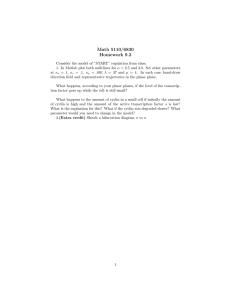
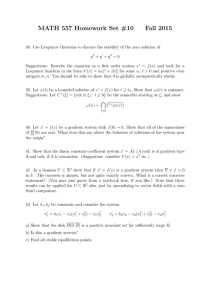

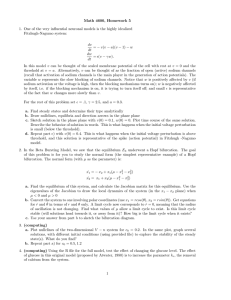

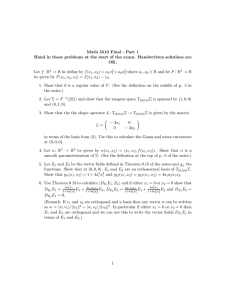
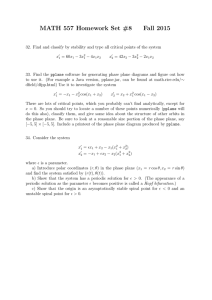
![Bifurcation theory: Problems I [1.1] Prove that the system ˙x = −x](http://s2.studylib.net/store/data/012116697_1-385958dc0fe8184114bd594c3618e6f4-300x300.png)
